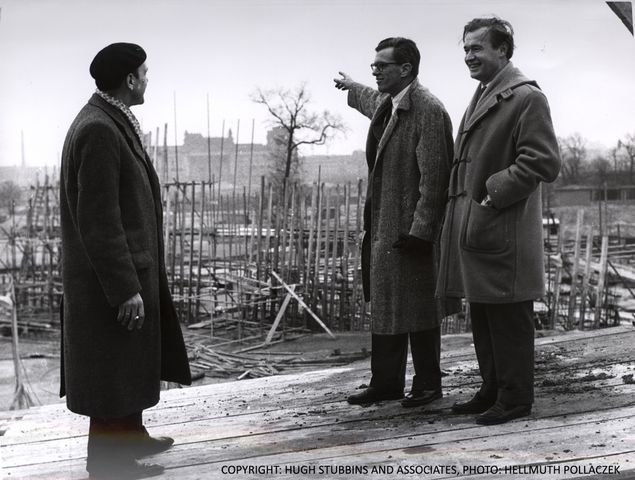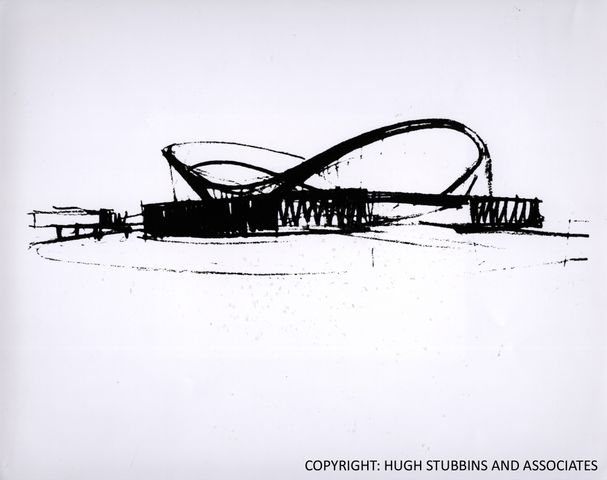Hugh A. Stubbins, Architekt der Kongresshalle
Michael Stubbins, Sohn des Kongresshallenarchitekten Hugh A. Stubbins, erinnert sich in seiner Rede zur Wiedereröffnung und Jubiläum des Gebäudes am 21. August 2007 an den Bau der Kongresshalle. Als Kind hat er zusammen mit seinen Eltern an den Einweihungsfeierlichkeiten 1957 teilgenommen.
„I remember seeing the pride in our father's eyes“
Director Scherer, Ladies, and Gentleman, Distinguished guests and friends of the Kongresshalle. My Brother Hugh, my Sister Patricia, my brother Peter and I share a great feeling of pride here today and are honored at being asked to attend this re-dedication and 50th anniversary of this magnificent building.
It was just over fifty years ago, with purpose, dedication and enthusiasm that great men and women of our nations put their minds and hands to work in a cooperative effort to create this wonderful structure.
Our Father was one of them.
I was a small boy of 6 or 7 years old the last time I was in Berlin the youngest of the 4 children, so please excuse my memory of those days; as it was a few years ago!!

My memories of Berlin from that time are filled with awe and wonder, I remember arriving here with my mother and father after flying in one of those great Silver Pan Am Clippers, the ones with the big rumbling engines. As I remember - back then it took 14 hours or more to make that transatlantic crossing. I remember driving through this city that was a sad collection of broken, torn, buildings and rubble, and thinking how terrible this was… I remember seeing great tall cranes that seemed to reach for the sky, I remember the smell of new concrete, jack hammers, construction equipment and the sight of new buildings rising where old ones had once stood. I remember checkpoints and the East and the West. I fondly remember the kind faces of Werner Duettman, and Franz Mocken, our father’s associates here in Berlin, as they made us feel welcome and at home amongst their families, far away from our own home. And; I remember, this building. I remember seeing the pride in our father's eyes and the sound of accomplishment in his voice as he spoke here at the ceremony - some 50 years ago.

Over the past several months I have looked through old pictures of that time and read and listened to speeches from the Richtfest and the dedication of the Kongresshalle. What seems to stand out in my mind after reading and listening to all this information, is what this building was intended to accomplish when originally conceived those 50 years ago.
A War had ended, rebuilding and healing had begun, there was a feeling of hope and enthusiasm for the future.
During this process our father was honored to be chosen to design and collaborate on a building for the 1957 exhibition here in Berlin.
After much discussion with associates, the state department, and the city of Berlin, the spirit of this building was conceived, it was to be a Kongresshalle; a center for creative thought and the free expression of ideas. During his speech here for the Richtfest 50 years ago our father said that this building was “Dedicated to the free exchange of thought and knowledge with the express intention of inviting International discussion, to encourage mutual understanding among nations, and a plan for a better World to live in.”
He designed the Kongresshalle at the forefront of his career and from here on he designed many prominent buildings throughout the World, emerging as an Icon of Modern Architecture. From simple gracious modern houses to foreign Embassy’s, he designed buildings that touched the sky, such as New York’s famous City Corp Center and Japan’s tallest building, the Landmark Tower in Yokohama, to the Ronald Regan presidential Library in California, to name just a few. My brother Hugh will tell you, as he is the other Architect of the family that with every building our father designed the most important aspect in his mind was how it would fill the needs for the people that would use it, would it be a comfortable place to work? Would it be open and allow creativity, and how it would fit within its surroundings? People were important!
In his speech here half a century ago, he said that this hall was also dedicated to one of the great freedoms – the freedom of expression. “It's form was inspired by an attempt to express that great purpose. “In this sense the form is a symbol” He said ... I believe a good symbol, - whether it actually is or not, is for others, and for the future to say”

He also said that he had the “deepest desire to know always, that it will be used freely and frequently, for the purpose for which it was planned.
I would say that if our father were to look down on this event here today that he would be both proud and satisfied to see that this House of World Cultures, this pregnant oyster, this Kongresshalle, is the symbol he hoped to create. And that his desire and the desires of all those who collaborated on creating this building whether on paper or by their own hands, has been reached. The future has said it is so.
The next generations will indeed speak for themselves, let us hope that this symbol of free expression is a beacon that helps guide them along the way and continues to provide a roof where under it, all who choose, will continue to congregate and express their ideas and dreams and, where people from all nations enjoy this structure that embodies the purpose - for which it was intended.
As a family we thank you all for helping us commemorate one of our father's greatest accomplishments. And I would also like thank the team here at the House of World Cultures, with special thanks to Director Scherer, Becky Ann Gilbert, Vera Dorsch, Jan Koehler, and Undine Zamani, who have been so thoughtful and gracious in helping to make it possible for us to attend this event. Along with a special note of recognition to Dr. Steffen de Rudder who’s published works have chronicled the history of this building and it’s architect; Hugh A Stubbins Jr.
Thank You.
Michael Stubbins, 21 August 2007
